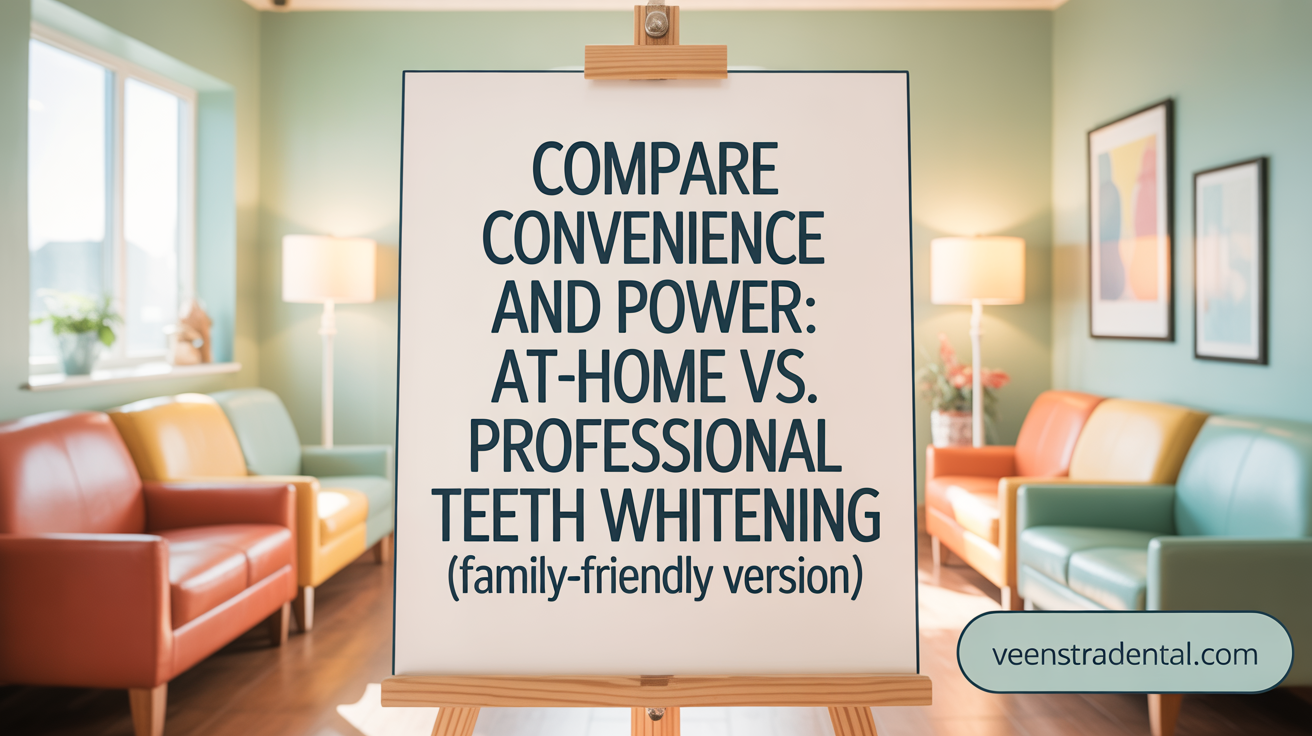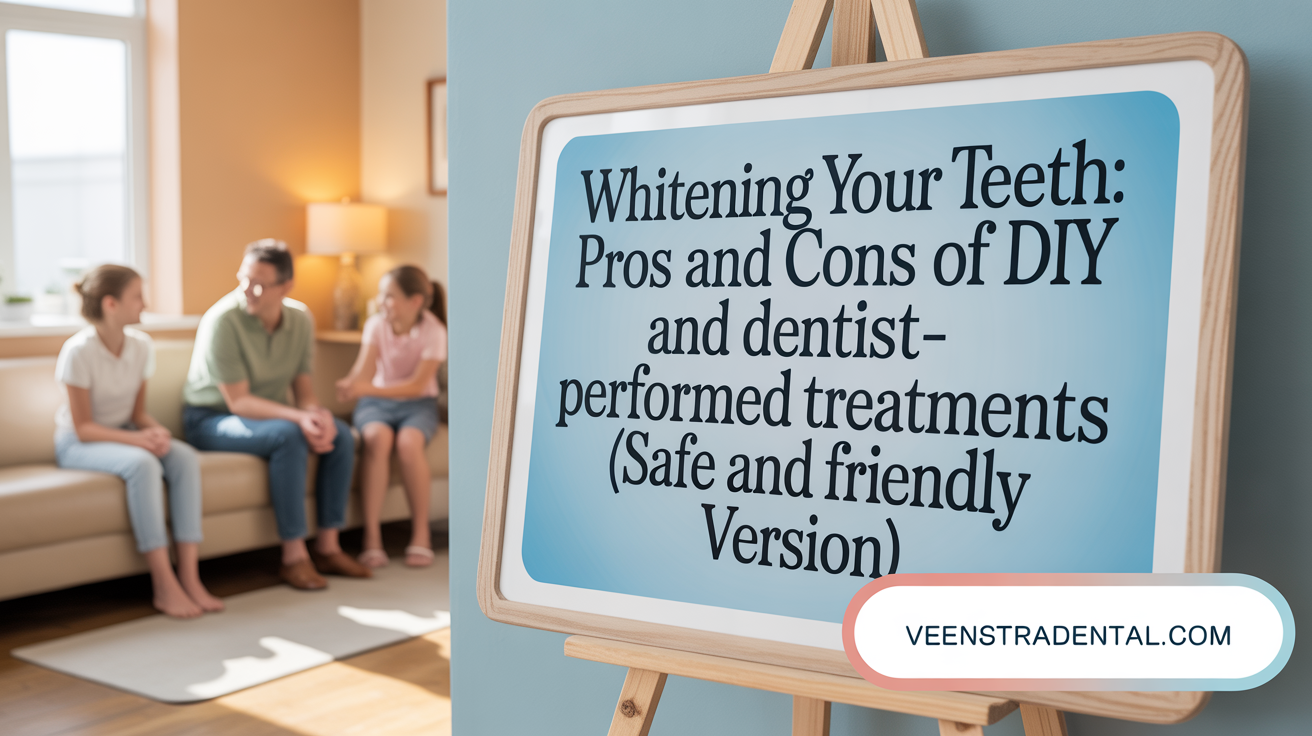Exploring the World of Teeth Whitening
Teeth whitening has become a popular cosmetic procedure to brighten smiles by reducing stains and discoloration. With various methods available, understanding the differences between at-home and professional teeth whitening is critical to making an informed choice. This article delves into the procedures, benefits, drawbacks, costs, and safety considerations of both approaches, helping you decide which method suits your needs.
Teeth Whitening Methods - Key Facts
- At-home whitening includes strips, gels, trays, pens, and LED systems for convenience and affordability.
- Active ingredients in at-home products mainly are hydrogen peroxide or carbamide peroxide, with concentrations varying from below 10% to 22%.
- Application involves daily or scheduled use of products like strips for 20-30 minutes, gel trays, or whitening pens, following clear instructions.
- Advantages of at-home whitening include cost-effectiveness, convenience, and suitability for mild to moderate stains, but results are less dramatic and slower.
- Safety concerns include tooth sensitivity and gum irritation; proper use and adherence to instructions are crucial, especially for sensitive individuals.
- Professional whitening is performed in-office with high-concentration gels (25-40%) and may involve special lights or lasers for quicker, more effective results.
- Professional whitening offers immediate, more noticeable, and longer-lasting results—often up to a year or more when combined with good oral hygiene.
- Cost comparison shows professional treatments costing $350–$1200 mostly, and at-home kits ranging $5–$600, with professional being more effective for stubborn stains.
- Choosing method depends on stain severity, desired speed, budget, and oral health; a dentist can recommend the best option after evaluation.
- In summary, professional whitening provides faster, more dramatic, and longer-lasting results, whereas at-home options are more economical but slower and milder.
1. At-Home Teeth Whitening: Convenience and Cost-Effectiveness
What types of at-home whitening products are available?
At-home teeth whitening offers a variety of products designed for ease of use and affordability. Common options include whitening strips, gels, trays, whitening pens, and LED light systems. These products are formulated to fit different preferences and severity levels of tooth discoloration.
Whitening strips are coated with a peroxide-based gel that adheres directly to teeth surfaces and are usually worn for 30 minutes daily. Gel and tray systems involve filling custom or over-the-counter trays with a bleaching solution before wearing them for a specified period. Whitening pens contain a liquid peroxide gel that can be directly applied to teeth, providing targeted treatment. LED systems often use small light devices to activate bleaching agents, enhancing overall whitening effect.
What active ingredients are used?
Most at-home whitening products contain active ingredients like hydrogen peroxide or carbamide peroxide. Hydrogen peroxide directly reacts with stain molecules to break them into smaller parts, resulting in a brighter appearance. Carbamide peroxide, which decomposes into hydrogen peroxide and urea, provides a gentler but effective bleaching action.
Some lower-concentration products use less than 10% peroxide, designed to minimize sensitivity and gums irritation. Higher-strength formulations, often dispensed by dentists for use at home, can contain around 16% to 22% peroxide, offering more potent results within a safe margin when used correctly.
How are these products applied?
Application procedures vary based on product type:
- Whitening strips: Placed over the teeth and left on for a recommended period, usually 20–30 minutes.
- Gel trays: Filled with peroxide gel and worn for scheduled sessions, often daily for 1–2 weeks.
- Whitening pens: Brushed onto teeth surfaces once or twice daily.
- LED systems: Battery-operated devices emit activating light while peroxide gels are applied, often used for 10–20 minutes.
Most products come with clear instructions, emphasizing consistent daily use to achieve satisfactory results.
What are the advantages and limitations?
Advantages:
- Cost-effective compared to professional treatments
- Convenient and usable at home, fitting into busy schedules
- Widely available over the counter or through dental providers
- Suitable for mild to moderate staining
Limitations:
- Less dramatic results than in-office whitening
- Slower process, often taking a few weeks
- Possible uneven whitening if not used correctly
- Not effective on intrinsic stains or restorations
Are there safety concerns and proper usage?
Safety depends on adherence to instructions. Overusing whitening products or applying higher-than-recommended peroxide concentrations can cause tooth sensitivity or gum irritation. Users should avoid swallowing gel and ensure proper fitting of trays to prevent contact with soft tissues.
Individuals with sensitive teeth, gum problems, or untreated cavities should consult a dentist before starting at-home whitening. It’s also advisable to use products that contain desensitizing agents if sensitivity occurs.
What results can be expected, and how long do they last?
Most at-home whitening products produce a whitening effect of 3–6 shades, judged by dental shade guides. Results typically appear after a couple of weeks of daily use.
The longevity of results depends heavily on habits such as diet, smoking, and oral hygiene. Proper maintenance, including the use of whitening toothpaste and avoiding stain-causing foods, can extend the brightness for several months.
What are the cost considerations?
Prices for over-the-counter whitening products usually range between $20 and $100, making them an affordable option for many consumers. Dentists’ professional at-home whitening kits may cost between $100 and $400, offering higher peroxide concentrations and better customization.
While more expensive initially, professional kits often deliver more noticeable results in less time, potentially reducing the need for repeated use of over-the-counter products.
Who is suitable for at-home whitening?
At-home whitening products are ideal for individuals with mild to moderate stains and those seeking an affordable, convenient method. They are also suitable for maintaining professional whitening results or for individuals with busy schedules.
However, people with sensitive teeth, gum issues, or dental restorations like crowns or veneers should seek dental advice before using these products, as whitening may not be effective or could cause complications.
| Aspect | Details | Tips |
|---|---|---|
| Types | Strips, gels, trays, pens, LED systems | Choose based on comfort and convenience |
| Ingredients | Hydrogen peroxide, carbamide peroxide | Check peroxide concentration for effectiveness |
| Application | Following specific schedules, consistent use | Adhere strictly to instructions to avoid sensitivity |
| Results | 3–6 shades brighter, visible in weeks | Be patient; maintenance needed for longevity |
| Cost | $20–$100 OTC, $100–$400 professional kits | Budget accordingly and consider long-term value |
| Suitability | Mild stains, maintenance, budget constraints | Consult dentist if underlying dental issues exist |
2. Professional Teeth Whitening: Rapid and Customized Results
What procedures are involved in at-home versus professional teeth whitening treatments?
Professional teeth whitening is performed in a dental office environment by trained professionals, ensuring a safe and effective process. This treatment involves several key steps, beginning with a thorough cleaning of the teeth to remove surface debris. Then, protective barriers are carefully placed on the gums to shield soft tissues from the bleaching agents.
The core of the procedure is the application of high-concentration bleaching gels containing hydrogen peroxide or carbamide peroxide, typically in the range of 25% to 40%. These concentrated agents are much stronger than over-the-counter products and are capable of penetrating deeply into the enamel for superior whitening. Sometimes, a specialized light or laser is used to activate the gel, accelerating the whitening reaction and enhancing the overall effect.
The entire process usually lasts about an hour, during which the dentist monitors the progress to ensure safety and comfort. The result is often a dramatic improvement—whitening teeth by several shades instantly. Importantly, because the procedure is performed under professional supervision, the dentist can take measures to minimize risks such as gum irritation or tooth sensitivity.
In contrast, at-home whitening treatments involve the use of lower-strength bleaching agents, often contained in gels, strips, or custom-fit trays. These products require daily use over a period of weeks and are generally less effective at producing rapid or dramatic results. While they can be convenient and affordable, they lack the concentrated power of professional solutions and do not typically include activation with special lights.
Use of high-concentration bleaching agents
The high potency of in-office bleaching gels contributes significantly to their effectiveness. These concentrations are carefully managed by dental professionals to optimize whitening while limiting adverse effects. This strategic control allows for deeper stain removal, especially with stubborn discoloration.
Protective measures during treatment
To ensure safety, dentists employ protective measures such as gum shields and barriers, preventing the bleaching agents from contacting soft tissues. Additionally, they monitor the process closely, adjusting treatment as needed to protect sensitive teeth and tissues.
Advantages over at-home methods
Compared to at-home kits, professional whitening offers quicker, more consistent, and often more substantial results. The use of stronger agents results in noticeable whitening after just one session, which is ideal for special occasions or severe stains. The customization of treatment plans by a dentist ensures that the whitening process is tailored to individual needs, providing a more comfortable experience.
Risks and safety under professional supervision
While high-concentration bleaching agents hold inherent risks of sensitivity or gum irritation, these are minimized when treatment is supervised by professionals. Dentists can apply desensitizing agents before or after treatment, adjust the concentration, and stop the procedure if adverse reactions occur, maintaining a high safety standard.
Result longevity and post-care
Results from professional whitening tend to last longer—often over a year—especially when paired with good oral hygiene practices and avoiding staining foods, drinks, or behaviors like smoking. Dentists may recommend follow-up treatments or touch-ups to sustain the brightness.
Cost and value
In-office whitening generally costs more upfront, typically around $650 or more. However, the speed, safety, and longevity of results often justify the investment. Many find that fewer visits are needed compared to multiple at-home kits, providing better value overall.
Ideal candidates for professional whitening
This treatment is well-suited for individuals with deep stains, severe discoloration, or those who want quick, noticeable results. Proper candidates include people with healthy teeth and gums, as the procedure involves stronger agents. Patients with dental restorations like crowns or veneers should consult a dentist, as these do not whiten and may require separate cosmetic procedures.
Differences Between At-Home and Professional Teeth Whitening Methods

What are the differences between at-home and professional teeth whitening methods?
The primary distinction between at-home and professional teeth whitening lies in the strength of the bleaching agents used and the results they produce.
Professional whitening, carried out by dental experts, employs higher concentrations of peroxide—such as hydrogen peroxide at 25-40%, significantly stronger than over-the-counter products. This allows the bleaching agents to penetrate deeper into the enamel, leading to faster and more dramatic whitening results, often improving teeth color by up to 8 shades in a single visit.
On the other hand, at-home whitening products contain lower peroxide levels, typically ranging from 3% to 10%. These include whitening strips, gels, trays, and toothpaste, which require consistent daily use over a span of weeks. The effects are generally milder, with an improvement of about 3-6 shades, and may take longer to achieve visible results.
In terms of treatment environment, professional whitening is done under the supervision of a dentist using specialized equipment like activation lights, customized trays, and high-grade gels. This supervision ensures proper application, reduces risks like gum irritation, and balances effectiveness with safety.
Conversely, at-home methods offer convenience and cost savings, giving control to users to perform treatments at their own schedule. They are generally safer due to the use of regulated, lower-strength formulas. However, they require careful adherence to instructions to avoid overuse and potential side effects.
While professional whitening offers faster, more noticeable outcomes that last longer—often over a year with proper maintenance—at-home kits are suitable for mild stains and serve well for touch-ups and ongoing maintenance.
Overall, choosing between the two depends on budget, desired results, and the severity of stains. Professional treatments are ideal for quick, significant whitening, especially for stubborn or deep stains, whereas at-home options are better suited for mild discoloration and routine upkeep.
Safety Considerations for Teeth Whitening Options
Why is a dental consultation important before whitening?
Before starting any teeth whitening treatment, whether at home or in a professional setting, consulting with a dentist is crucial. A dental exam helps identify existing dental issues like decay or gum disease that could be worsened by bleaching agents. Dentists can recommend the most appropriate method based on individual oral health and staining severity.
What risks and precautions exist with bleaching agents?
Bleaching products contain hydrogen peroxide or carbamide peroxide, which can cause temporary gum irritation or tooth sensitivity if misused. Overuse or unapproved DIY remedies like lemon juice can damage enamel and soft tissues. Professional supervision allows for controlled application of high-concentration agents, reducing these risks. Using products exactly as directed and avoiding unverified treatments are vital safety steps.
How do whitening treatments affect teeth and gums?
Both at-home and in-office whitening solutions can lead to side effects such as increased tooth sensitivity or gum inflammation if improperly applied. Proper fitting of whitening trays, the use of protective gel guards, and careful application prevent contact with soft tissues. In-office treatments involve application of protective barriers, further reducing the risk of tissue irritation.
Are there special considerations for sensitive individuals and those with dental restorations?
People with sensitive teeth should discuss options with their dentist, as some whitening agents may worsen discomfort. Desensitizing treatments are often included in professional procedures. Individuals with crowns, veneers, or fillings should note that these do not whiten and may need replacement for uniform appearance. Regular dental checkups help ensure safety and optimal aesthetic results.
| Aspect | At-home whitening | Professional whitening | Safety notes |
|---|---|---|---|
| Typical agents used | Hydrogen peroxide, carbamide peroxide | Higher concentration keratings like 25-40% hydrogen peroxide | Supervision improves safety; avoiding overuse is critical |
| Application duration | Several weeks, daily use | About one hour per session | Controlled application reduces risks |
| Potential side effects | Sensitivity, gum irritation, uneven whitening | Fewer side effects, managed by professionals | Proper sealing and gel application mitigate risks |
| Effectiveness | Mild to moderate stains, gradual results | Deep stains, dramatic, immediate results | Supervision ensures safety and optimal results |
| Impact on restorations | No whitening of crowns/veneers | Does not whiten restorations; may require repair | Necessary to discuss restorations with your dentist |
Maintaining oral health after whitening involves good hygiene, avoiding stain-causing foods, and regular checkups. When done properly, both options can be safe and effective, but professional guidance greatly enhances safety and outcome quality.
Benefits and Drawbacks: Weighing At-Home Against Professional Whitening

What are the benefits and drawbacks of at-home versus professional teeth whitening?
Professional teeth whitening provides quicker, more pronounced results, often improving teeth color by up to 8 shades in just one visit. This speed is due to higher concentrations of bleaching agents used by trained dentists, who also ensure proper application and monitor for side effects. The supervision at the dental office reduces risks such as gum irritation and sensitivity, making the process safer, especially for deeper stains. Benefits include longer-lasting effects and personalized advice for maintaining whiteness. However, professional treatments come with a higher cost, typically ranging from $650 or more, and require an appointment during work hours.
In contrast, at-home whitening methods are more affordable and convenient, allowing individuals to conduct treatments at their own pace and schedule. These options include whitening strips, gels, trays, and toothpaste, which use lower-strength bleaching agents to reduce the risk of sensitivity and irritation. The main drawback is that results tend to be subtler, typically achieving 3-6 shades of whitening over several weeks. Additionally, improper use can increase the risk of uneven results or gum sensitivity.
Ultimately, the best choice depends on individual goals, budget, and dental health. Professional whitening is ideal for those seeking rapid, significant results or dealing with stubborn stains, while at-home options suit mild discoloration or maintenance after professional treatment. Proper supervision and application are essential in both approaches for safe and effective whitening.
Cost Comparison Between At-Home and Professional Whitening

How do the costs of at-home and professional teeth whitening treatments compare?
The prices vary considerably between at-home and professional whitening methods. Professional treatments, which are performed in a dental office using high-concentration bleaching agents, typically cost from $350 to $1,200. The average expense hovers around $575. These treatments offer quick, noticeable results, often achievable in just one visit, and tend to last longer when proper oral care is maintained.
On the other hand, at-home whitening options, such as over-the-counter whitening strips, gels, trays, and pens, are generally much more affordable. Their prices usually range between $5 and $600, with most products costing around $50 to $150. While these products can be effective for mild to moderate staining, they require consistent use over weeks to see results, which are typically less dramatic compared to professional treatments.
Cost effectiveness relative to results
Although professional whitening entails a higher upfront cost, it often provides more significant, faster, and longer-lasting results. This makes it more cost-effective in the long run if rapid and effective whitening is desired. For those with severe stains or those needing quick results for special events, investing in professional treatment might minimize the need for repeated applications.
Conversely, at-home kits are less costly and offer good options for minor discoloration or maintenance. They are ideal for individuals on a budget or those seeking a gradual improvement without visiting the dentist. However, they may require ongoing use and re-purchasing, which can add up over time.
Factors influencing the cost
Several factors can influence the overall expense, including the severity of teeth discoloration, the type of whitening product used, and whether treatment is done professionally or DIY. Custom-fit trays from a dentist or advanced LED-light systems tend to increase costs but can enhance effectiveness.
Budget considerations for users
Choosing between these options depends on personal budget, whitening goals, and urgency. While professional whitening costs more initially, it often reduces the need for repeated treatments. Over-the-counter products are less expensive upfront but may require ongoing purchases and yield less dramatic results.
| Treatment Type | Typical Price Range | Average Cost | Main Advantages | Main Disadvantages |
|---|---|---|---|---|
| Professional in-office | $350 - $1,200 | ~$575 | Fast, dramatic, long-lasting results | Higher cost, time in clinic |
| Take-home professional | $150 - $400 | ~$250 | Customizable, effective, safer for enamel | Still more expensive than OTC, requires dentist visit |
| Over-the-counter kits | $5 - $600 | ~$50 - $150 | Affordable, convenient, usable at home | Slower results, less effective for deep stains |
In summary, the choice hinges on individual priorities: immediate, noticeable whitening versus budget considerations. For optimal results, consulting a dental professional can help determine the best approach based on the severity of discoloration and personal preferences.
Choosing the Right Teeth Whitening Method for You
How can someone decide which teeth whitening method is most appropriate for their individual needs?
Selecting the best teeth whitening approach depends on several personal factors. The severity of discoloration, whether caused by surface stains from coffee, tea, or smoking, or deeper intrinsic stains, can influence whether over-the-counter products or professional treatments are more suitable.
For mild to moderate surface stains, at-home options like whitening toothpaste, strips, or trays may provide satisfactory results. However, for stubborn or deep stains, especially those caused by aging or medication, professional whitening in a dental office often yields faster and more noticeable improvements.
Dental consultation plays a vital role in ensuring safety and effectiveness. A dentist can assess the health of your teeth and gums, identify any underlying issues like decay or gum disease, and recommend a tailored treatment plan.
Treatment goals and expectations should also guide your choice. If immediate, dramatic whitening is desired—such as before a special event—professional treatments offering up to 8 shades of whitening in a single session are ideal. Conversely, if you prefer a gradual approach and have a limited budget, at-home kits may be sufficient.
Managing sensitivity and existing oral health concerns is crucial. Professionals can incorporate desensitizing agents or modify treatment methods to minimize discomfort. Overuse of whitening products, especially over-the-counter ones, can lead to tooth sensitivity or gum irritation.
Ultimately, consulting with a dental expert ensures the selection of a safe, effective, and personalized whitening plan. This ensures the procedure aligns with your cosmetic goals while safeguarding your oral health, providing results that are both satisfying and long-lasting.
What to Expect From At-Home Versus Professional Teeth Whitening Treatments

What can one expect in terms of results and experience from at-home versus professional teeth whitening treatments?
When choosing between at-home and professional whitening procedures, understanding what each involves can help set expectations. Professional whitening treatments are designed to produce rapid, noticeable results. Usually completed within about an hour in a dental office, these treatments use higher concentrations of peroxide gels that penetrate deeper into the enamel. They often produce whitening improvements of up to 8 shades in a single session, making the teeth significantly whiter and brighter.
In contrast, at-home whitening products such as strips, trays, rinses, and whitening gels generally contain lower levels of peroxide or carbamide peroxide. These options are more affordable and convenient, allowing individuals to perform treatments at their own pace over several weeks. Typically, at-home kits result in a gradual lightening of teeth by 3 to 6 shades. The process is less aggressive, which often leads to milder results that may be less uniform, especially on deeper or intrinsic stains.
From a patient comfort perspective, professional whitening offers additional benefits. Dentists take protective measures to prevent gum irritation and manage sensitivity, ensuring a safer and more comfortable experience. Over-the-counter and customized at-home kits carry a slightly higher risk of uneven whitening or transient sensitivity if instructions are not followed properly.
Regarding the longevity of results, professional treatments tend to last longer—often over a year—especially with good oral hygiene and avoiding stain-causing foods and drinks. The deeper penetration of professional agents means the whitening effect is more durable. At-home treatments, while effective for maintaining initial whiteness with regular touch-ups, generally require ongoing use to sustain results, which may fade faster over time.
In summary, professional whitening offers faster, more dramatic, and longer-lasting results with a safe environment under dental supervision. Conversely, at-home options are suitable for those seeking modest improvements, convenience, and lower costs, but with results that develop more gradually and may need more frequent reapplications.
Making the Best Choice for Your Smile
Both at-home and professional teeth whitening methods have distinct advantages and considerations. At-home kits provide an affordable and accessible way to gradually brighten teeth, suitable for mild stains and those seeking convenience. Professional whitening offers rapid, customized, and long-lasting results with the benefit of dental supervision and care, ideal for stubborn discoloration or quick enhancements. Consulting with a dental professional is the best way to evaluate your oral health and choose the method that matches your goals, sensitivity, and budget, ensuring a brighter, healthier smile safely and effectively.
References
- Professional Teeth Whitening vs. At-Home Teeth Whitening
- What's the Difference Between Professional Teeth Whitening and At ...
- At-Home vs Professional Teeth Whitening | Walnut Creek California
- Whiten Teeth at Home or in the Dentist's Office? - WebMD
- Teeth Whitening Options: At-Home vs. Professional Treatments
- Professional Teeth Whitening vs. At-Home Kits - Smiles Los Gatos
- In-Office vs At-Home Teeth Whitening - Consumer Guide to Dentistry
- Professional Teeth Whitening Options: In-Office vs. At-Home
- Why You Should Get Professional Teeth Whitening Over Teeth ...
- Professional Teeth Whitening vs. At-Home Whitening Kits
